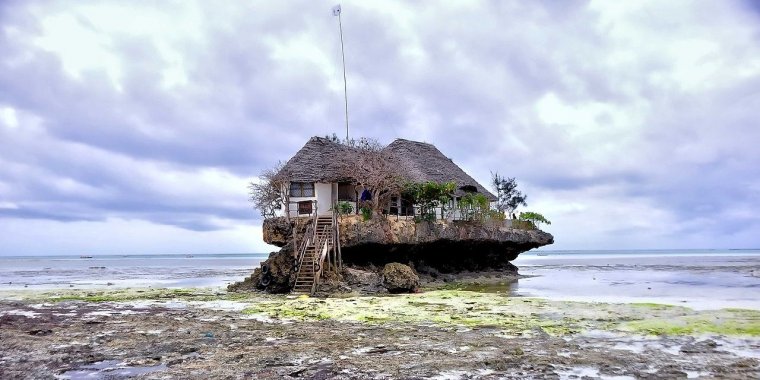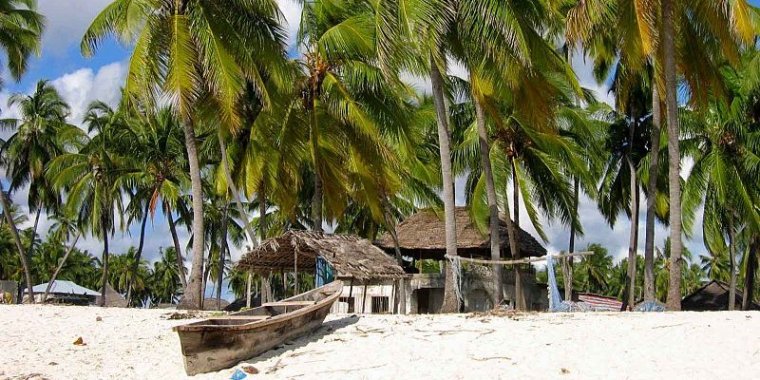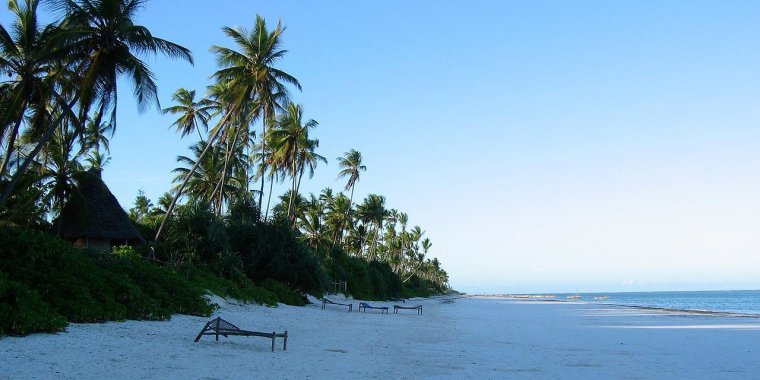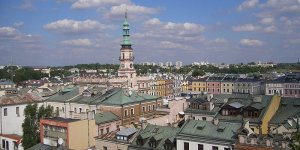| Published in Destinations |
Zanzibar, Tanzania
Zanzibar is a semi-autonomous archipelago off the coast of Tanzania, consisting of Zanzibar Island (locally, Unguja), Pemba Island, and many smaller islands. Zanzibar island is approximately 90 km long and 30 km wide.
Cities
• Stone Town – the vibrant and somewhat enchanting capital.
• Nungwi – a popular small resort town on the northern tip of the island.
• Kendwa – a small fishing village a couple of miles from Nungwi, a great place for reading on the beach or scuba diving.
• Matemwe.
• Jambiani – fishing village stretching miles along the beach with lots of small hotels and guesthouses.
• Paje – a small village on the east coast known for excellent kiteboarding conditions.
• Uroa Village – a small fishing village on the east coast, resorts on the northern and southern side.
• Kizimkazi – a small village on the south coast and starting point for dolphin tours.
• Chwaka - a small fishing village by the sea.
The larger and more populated of Zanzibar's two main islands, Unguja is separated from its northern neighbor Pemba by 48 km of open sea. The mainland of Tanzania, which lies to the southwest of Unguja and is separate from it by the Zanzibar Channel, is considerably closer, as is the major Tanzanian mainland port of Dar es Salaam.
Smaller islands surround the coast, notably Tumbatu in the northwest, Uzi in the south, and Mnemba Atoll in the northeast. A considerable number of smaller islands and reefs lie off Unguja's southwest coast.
Get in
By boat. There are many ferries and catamarans that can take you between Dar es Salaam and the Island. Azam Marine, Sea Express, Sea Star, Seagull Kilimanjaro and Sepideh Megaspeed Liners are among the nicest available. Some of these are run by Azam (2 hr, US$35 for non-residents, leaving Dar es Salaam at 07:00, 09:30, 12:30 and 15:45 and returning from Stone Town at 07:00, 09:30, 12:30 and 15:30).
Depending on demand, weather and condition of the boats additional ferries may run at different times. Be sure to arrive at the port at least 30 minutes in advance to allow for emigration, luggage security checks and to secure a good seat on the boat.
First class is US$5 more expensive than economy and often not worth the money: While there’s good comfortable seating, you’ll stay in a freezing room with the A/C set to 18°C and foreigners are often allowed in first class anyways, since they already pay around 2½ times the local price. If you prefer to stay on the sundeck outside, choose economy.
The quoted US$ price may be more expensive when paid in local currency, so it may be a good idea to exchange money first.
Flying Horse makes the same journey for US$20. However, it will take around 4½ hours. There are also evening departures on a slow night ferry. It runs towards the destination and anchors there until the morning before it enters the port. This has been reported to be a beautiful trip, but security is an issue and close attention to belongings must always be paid.
You may be able to hire a private boat for cheaper, but the trip will take considerably longer and unless you know something about boats, you could be on a vessel that is not equipped for bad weather conditions or an emergency. Remember: you get what you pay for.
While not advisable there are also dhow connections, e.g. to Bagamoyo (4-8 hr, TSh 5,000). Since you’re not arriving through official customs on this route you may need to pay a departure tax of US$5 on exit and face some questionnaires.
Day trips. Ferry schedules allow you to do the return trip the same day. For instance leave Dar es Salaam at 07:30 and return from Zanzibar on the 15:45 ferry. That leaves plenty of time to explore the Stone Town, the museum and have a nice lunch. The trip is beautiful and lasts about 2 hours. However, if the weather is bad it can take much longer and the trip can be very unpleasant. The on-board personnel hands out free sickness bags at the start of the journey.
Touts and annoyances. Be aware that the "porters" at the Dar ferry terminal will hassle you for money, expect tips for referring you to "the best boat" or guide you to a ticket office that sells tickets at inflated prices. To avoid touts be forceful and head straight towards the ticket office of the ferry you intend to take.
Beware that touts will tell you anything to get you to use a service which pays them commission, and scam you in any way they can. They will say the company kiosk you are heading towards is closed, the ferry runs only later or only goes to mainland destinations (when they do service Zanzibar), they will say their service is a 90-min ferry (when it actually takes over 2 hours), they will quote you a price for first class tickets (but issue "e/c" economy tickets and pocket the difference), they will sell you a return ticket (leaving you to later find out it is actually only valid for return travel with a different, cheaper company and the seller has pocketed the difference). The dock is a zoo -- a prime hangout for pickpockets.
Passport. Although Zanzibar is part of the Union it maintains its own immigration service and you need to have a valid passport to enter, even if you come from mainland Tanzania. This farcically means you must fill out a Tanzania arrival card for your arrival in Stone Town, and a Tanzania departure card when you leave. Also note that immigration in Zanzibar may check your vaccination records for yellow fever.
• By plane. Abeid Amani Karume International Airport (ZNZ) located on Unguja Island, it is about 5 km (3.1 mi) south of Zanzibar City.
Airlines that fly to Zanzibar are: Regional Air, Precision Air, ZanAir, Coastal Aviation, Tropical Air, Mango, Flydubai, Qatar Airways, Oman Air, Auric Air, Kenya Airways, Ethiopian Airlines, and Fly540.
In January 2014, Coastal was charging US$70 for a one-way flight from Dar with a 15-kg baggage limit preferably in soft bags. The planes are small, so luggage can be an issue if you're doing a lot of shopping. A Precision Air ticket will cost a bit more but with a more generous baggage allowance.
Zanzibar has 2 departure taxes: domestic flights TSh 5,000 (or US$5), and international flights US$30. For almost all cases though, this tax is incorporated into your flight ticket price.
Taxi. There are taxis waiting for passengers when you exit the terminal. Despite having a "list" of prices for the various tourist destinations on the island, prices are negotiable. Although you can arrange a pick up at the airport with your hotel or tour company, even a little negotiating will get you a better price than the inflated one quoted by most hotels. However, some Stone Town hotels do offer free shuttle service from the airport.
Get around
• By taxi. Journeying outside Stone Town is most comfortably done with a taxi or a private car. The latter are essentially also taxis with drivers although they don't have the official taxi designation. They may however be a bit cheaper than a cab (10-20%) and your hotel receptionist can likely arrange one for you (the hotel may charge you a hefty commission Airport-Nungwi US$60 - compare below). Be sure to negotiate the price before and know the street price so you don't end up paying an overly high commission instead.
Sample fares include: Stone Town to Nungwi or Kendwa: 1½ hr, from TSh 60,000; Airport to Nungwi: Tsh 65,000; Nungwi to Kizimkazi: 2 hr, from TSh 80,000; Airport/Stone Town to Paje: 1 hr, from TSh 50,000.
• By daladala. A network of daladalas, minivans, small buses and sometimes pickup trucks, exist which service all the major villages on the island at a very cheap price (any route on the island should be less than TSh 2,000 per person). The adventurous, armed with a phrase book and map, will experience a wonderful side of Zanzibar life, which all too often is just another photograph to the typical tourist zooming past. It will take you a good 2 hours to get to Nungwi, on the northern tip of the island.
There’s no daladala service running north to south. Instead you’ll have to go via Stone Town again and change buses there.
• By car. Driving by yourself can be dangerous and may not be common place. Roads are sometimes in horrendous condition and all kind of obstacles (sudden bumps, animals, people, etc.) are to be expected at any time. Avoid driving at night if you can. Driving with the upper beams on the whole time is a stupid but unfortunately common practice that you shouldn't imitate. It is enough that one person cannot see.
That said a car will give you freedom to explore and may save you a lot of time. Even a one day and one way car hire may make sense, as the car can be delivered to and picked up from your hotels in the morning and evening, e.g. Nungwi to Stone Town (US$30 for a small 4x4 Escudo).
Petrol is priced at TSh 2,210 per liter (Nov 2017) and gas stations are well distributed on the island. Don't take chance on running out of petrol though.
There are many police checks on the roads. So make sure you have your driving licence, the temporary Zanzibar drivers permit, and the car insurance sticker on the windscreen. Also check that the rental car is roadworthy and the police will wave you through with a kind jambo.
The temporary Zanzibar drivers permit can be obtained from local authorities. However, if you ask your car rental company in advance, they should be able to get it for you and deliver it with the car. They probably need a photocopy of your home driving licence (a photo sent via e-mail should also work). Expect to pay about TSh 16,000 for the licence.
Hotels are happy to arrange a taxi or rental car for you although they might add some (sometimes: a lot) commission to the price.
It has been reported that police invent "offences" to get bribes. One scheme may involve to threaten to go to trial in a couple of days. They may even jump in your car on the grounds that you have to drive them to the police station. However, when they state "How can we sort this out?" Tsh 1,000-5,000 will be enough to forget the "offence".
What to See in Zanzibar
• Jozani Forest has excellent nature trails, featuring some very exotic (and large) trees. Even more interesting, though, are the Red Colobus Monkeys that live here. Native to the Island, these monkeys are now nearly extinct. They are very curious and playful and will likely pose for a picture. The entry fee (US$8) includes an optional visit to a beautiful mangrove forest which is highly recommended.
• Stone Town. — The inner city was declared a UNESCO World Heritage Site in 2000. Blending Moorish, Middle Eastern, Indian, and African traditions and architectures, it is possible to spend days winding through Stone Town's labyrinthine alleys. That said, a day will give you plenty of insight.
The inner city is small and can easily be explored by foot. It is estimated that 85% of the historic building fabric (coral stone) of Stone Town is irredeemably lost. Only very few of the old magnificent buildings shine brightly, i.e. if they have been converted to (boutique) hotels, clubs, or restaurants. Most buildings are in bad shape and the rough sea climate has taken its toll on the structure.
While in Stone Town, you can shop for souvenirs, drink the occasional tea, or visit the few city's historic sites. Be aware that -being close to the equator- even the narrow alleys may offer little shade/protection from the sun. Water is also important and can be bought in plenty of stores along the way.
— The House of Wonders is closed due to reconstruction work (Oct 2014). It carries this name because it was the first house in Stone Town to have electricity, running water, and an elevator.
— Former Slave Market (entry fee is TSh 7,000 - this fee includes a guide (Oct 2014), who you may or may not tip). This is the site of the old Slave Market. The museum only consists of slave chambers (one for 50 men and one for 75 women and children), a memorial, and an Anglican Church built on the site of the tree that served as whipping post. It provides only very limited information on the history of the building or slave trade in Zanzibar.
Apart from the slave chambers nothing is left, as a hospital has been built into the old market. However, you can go into the holding chambers in the cellar to see how this wretched piece of history played itself out in small dark dungeon-type cells. The property was purchased by Dr David Livingstone (one of the biggest proponents of the abolishment of slavery) who wanted to turn the grounds into a haven after the atrocities committed there by the Oman Arab and British slave traders.
What to Do in Zanzibar
• Spice tour. Zanzibar Island, a.k.a., the Spice Island, was an important stop in the Spice Trade centuries ago. Today, it is one of the few places in the world where saffron is produced, and many other Middle Eastern/Asian spices (cardamon, ginger, cloves, nutmeg, etc.) are grown here.
Several companies take you on a tour which winds you around the island, showing you how cinnamon, jack fruit, kurkuma or anise (licorice) are grown; letting you sample some of the exotic fruit grown on the island; and allowing you to tour the beautiful plantations. In Stone Town be wary of booking and paying directly on the street, in which case the tout might just take your money (from US$10) without a booking.
Another common scam is for a tout to follow you into (or give you directions to) the office, in which case the tour price will increase by US$5, with you paying the commission. If you have a car you can drive to the Kizimbani area yourself, where spice tours are offered. Again, depending on your bargaining skills you may be able to get it for Tsh 22,500 (two persons) plus the tips (TSh 6,000).
On the tips: you will be expected to tip the guy that climbs up the coconut tree singing a song (yes, it is that touristy), the guy that does the fruit tasting, the guy brading stuff from palm leaves while you walk around, and of course your guide. Usually TSh 1,000-2,000 should be fine. While you have never asked, nor were made aware of this entourage, this is how their scheme works. Given the nature of this even more people may show up during your tour and may expect tips.
• East Beaches. The seemingly endless beaches near Paje or Jambiani are very popular among travellers. The sand is brilliant white, and the warm waters of the Indian Ocean are a deep teal.
• Kendwa Beach (on the North Western coast, some km south of Nungwi). With a beautiful sand beach, here you can swim during low and high tide, which is not always possible on the East side of the island. Just beware of the Sea Urchins that give a powerful sting if stepped upon during low tide. Kendwa offers lots of beach bars and restaurants serving everything from pizza to local curries.
Kendwa Beach is also known for the Full Moon Party, arranged Saturdays just before or after a full moon. While not as big or extreme as those arranged in Thailand, the parties on Zanzibar attract quite a large group of people, especially when the full moon coincides with public holidays in Europe and North America (i.e. Easter and Christmas).
• Scuba diving and snorkelling. Cristal clear water and beautiful reefs make Zanzibar a great place for underwater activities. Unfortunately, in some areas reefs are in poor condition and fish populations are low. Snorkel boat trip with equipment from US$35 per boat.
• Dolphin tour. This intense (but not necessarily moral) tour starts in Kizimkazi on the south tip of the island and includes snorkelling and chasing dolphins. Tours can be arranged from Stone Town to the village, a few hours boat tour that, local lunch, nap on the beach and an optional tour to Jozani Forest. The full tours leaves town at 8AM and comeback at 5PM - a complete day of fun and a very memorable experience, especially for the dolphins.
• Ride on a local's dhow. These traditional boats make for a wonderful sunset cruise.
• Sit and stare at the water for hours on end.
• Zanzibar Butterfly Centre (Located near to Jozani National Park). 9AM - 5PM. The Zanzibar Butterfly Centre is a community development project and tourist destination just down the road from Jozani Forest. Revenue from admissions is used to pay farmers in the village sustainably farming butterflies.
This genuine little project really makes a real difference to the farmers' income and provides a wonderful experience for visitors as they can see spectacular local species flying close at hand in a beautiful tropical garden. US$5 per person.
Buy
Zanzibar currency is the Tanzanian shilling (Tsh). On the beaches, US dollars and shillings are accepted, but at US dollars receive much less than the official exchange rate. Best would be to trade some of your dollars or euros for shillings, and use that to buy food. If you buy curios with dollars and euros you will get a better deal, since the hawkers are more prone to bargaining when buying with foreign currency.
You get a better exchange rate on $50 and $100 notes, than on $20 and $10 notes. There are four ATMs on the island, all in Stone Town. A store that accepts credit card payment is a rarity. Don't rely totally on your bank card. Take extra cash.
Stone Town is a one-stop-souvenir-shopping for the traveller. You can find beautiful textiles, handmade jewelry, intricate wood or stone carvings, spices, knick-knacks, etc. Buy a cookbook and spices. Take the trip home with you! Beware that many of the vendors sell fake saffron (appears waxy like a shredded red crayon).
Barclays bank has a Visa Card/Mastercard ATMs at Zanzibar Main Karume Road Stone Town and Darajani.
Eat
Zanzibar cuisine offers a much greater variety than the mainland one. While the usual cheap eating stalls cater the same ubiquitous chapati, rice, chips and Ugali dishes, esp. in Stone Town a lot of great food can be found.
Forodhani Gardens opens in the late afternoon. Forodhani Gardens is a nightly affair by the water. It is not to be missed place to eat in Zanzibar. It starts at around 5PM and gets busy after the sun sets. If you are not scared of local food, then this place is definitely worth a visit. A large open space with many food stalls and local food. Here you can also get the famous Zanzibar pizza, something like a savory crèpe, filled with beef, eggs and salad in the default version.
It is possibly the cheapest food you will find on the island, and value for money too. Ranging from crab claws, calamari steaks to plain old chips done in big woks. You are well advised to try the local sugar cane juice.
A few prices as of Oct 2014 - depending on your bargaining skills you may be able to get lower prices: Zanzibar beef pizza (TSh 3000 - delicious!), small sugar cane juice (TSh 1000), shrimp on a stick (TSh 5000), octopus (whole) on a stick (TSh 6000), small beef on a stick (TSh 300 - usually three or four are bought at a time and dipped into a hot sauce before finally barbecued), chicken massala on a stick (Tsh 3000).
Some consider the market to be overrated -- the food quality can be mixed and food stands will advertise their food. The twilight atmosphere, however, makes for a nice setting to have a cheap meal.
Nearly all beach hotels also include restaurants with typical western cuisine at varying degrees of quality. Mains usually start around Tsh 10,000.
Drink
While predominantly a Muslim community, small bars can be found everywhere in Zanzibar.
The sugar cane juice and fresh coconut milk that are mainly available in Stone Town are not to be missed. Try the ginger beer (tangawizi, also available on the mainland) which is not a beer, but a soda with a spicy ginger flavor. Beach bars on the beaches will supply you with good local beer and cocktails. You must try a Dawa-cocktail!
The Old Dispensary has a basic "top storey" bar which offers nice views on the harbour and beaches (local beer: TSh 4000). Despite its location it is off the beaten track and you may find yourself with a few locals and a band sipping at quite some height.
Sleep
Zanzibar does not offer much of cheap accommodation. The cheapest budget hotels in Stone Town start from TSh 25,000 for a double, and normal budget hotel prices range TSh 45,000 to 90,000 and that's during the low season, where several hotels stay closed due to lack of customers. The quoted prices are after bargaining: low-season is a good time to do so and not having your bags with you when doing so, will also give you a boost.
Accommodation at the beaches is often more expensive, with the cheapest options starting at TSh 50,000.
Respect
Zanzibar is largely a Muslim community. Although they are used to Western ways, you should try to be respectful. This means:
— Women and men should make an effort to cover their legs and arms (being in a bikini on the resort beach is fine though).
— It is regarded as disrespectful to show public affection.
— Be discreet when drinking alcohol.
— During Ramadan -- the month of fasting -- travellers should avoid eating and drinking publicly during the daytime. Also, be sure not to smoke in front of people, nor chew gum, and it is polite to avoid talking about the nice lunch you had.
Go next
• Pemba, the quieter island is a short flight or ferry ride away.
• Dar es Salaam, the largest city in Tanzania is well connected by air and by ferry. See Get in by boat for details on the ferry.
• Arusha, the gateway to the northern safari circuit can be reached by direct flights from Zanzibar or by a more than 12-hr bus trip from Dar es Salaam. (Wikivoyage)

The Rock Restaurant, Zanzibar. ![]()
YOU MAY ALSO LIKE



 If you own or manage a travel-related business such as a hotel, a bed-and-breakfast, a restaurant, a pub or a cafeteria, you can create a web page for your business for free on Titi Tudorancea Travel Info. » |




